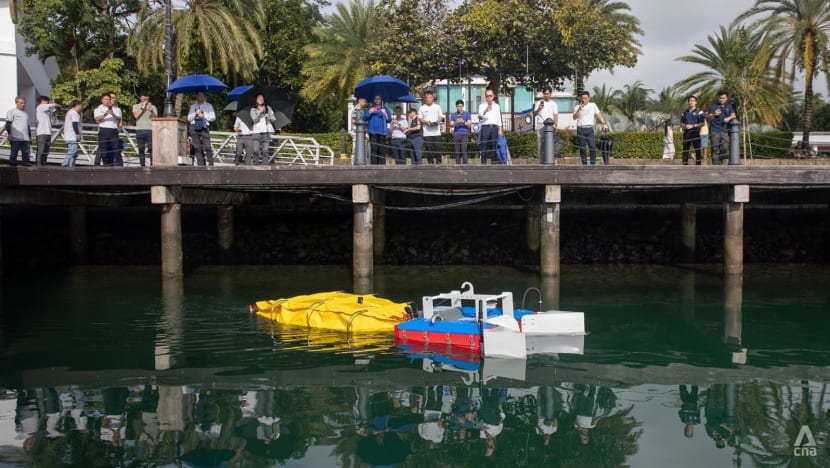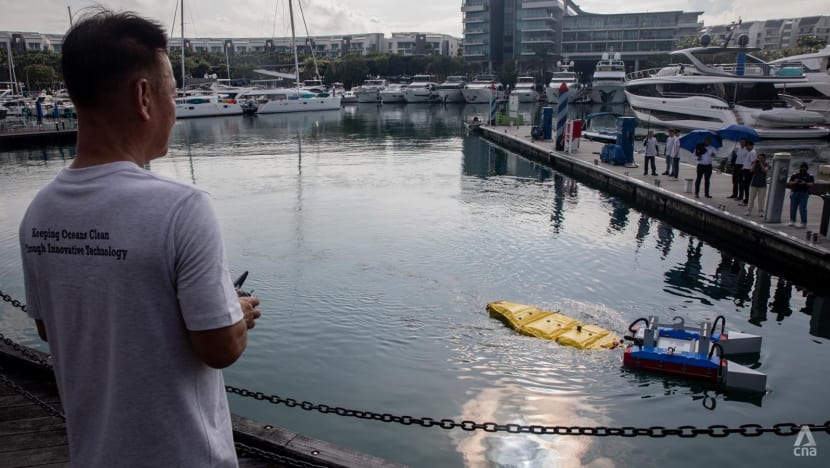Floating robot, oil-vaporising laser gun among possible new tech to tackle oil spills in Singapore
Demonstrating and testing new technologies is part of the Maritime and Port Authority of Singapore's efforts to better manage incidents such as oil spills.

Korea Oceanic A.I. (KOAI) demonstrating its oil spill recovery robot, KOBOT-S, at ONE°15 Marina at Sentosa Cove on Oct 10, 2024. (Photo: CNA/Ili Nadhirah Mansor)

This audio is generated by an AI tool.
SINGAPORE: A robot that collects oil on the water’s surface and a laser gun that can vaporise oil stains are among new technologies that Singapore is exploring to tackle future oil spills.
These solutions could have helped in the aftermath of the June oil spill that occurred in the southern waters of Singapore, said their developers at a media demonstration on Thursday (Oct 10).
The Maritime and Port Authority of Singapore (MPA), which organised the demonstration, said in a statement on Friday that testing new technologies is part of ongoing efforts to boost its incident management capabilities and provide testbed opportunities for innovators.
The demonstrations were part of the biennial Joint Oil Spill Exercise, which tests agencies and companies on their response to oil spill incidents.
The Korean-made robot - called the KOBOT-S - is remote-controlled and acts as a “first responder” when there is an oil spill.
It does this by using “ratchet technology”, a cylinder made of a nanomaterial foam structure that is super absorbent and capable of separating oil and water.
The foam structure has ridges, and it spins and siphons oils of both high and low viscosity into a storage bag.
The floating device can recover between 200kg and 500kg of oil on the water’s surface per hour into the bag, which holds up to 700kg of oil. The storage bag can then be detached and swapped out when full.

Developed by Korean marine pollution control company Korea Oceanic Artificial Intelligence (KOAI) and supported by Hyundai Corporation, the robot has a battery life of about three hours.
The company demonstrated the device's capabilities to the media on Thursday at the waters of ONE°15 Marina at Sentosa Cove.
The 4.5m long, 160kg robot manoeuvred easily in the water, controlled by KOAI chief executive officer Tony Park.
Mr Park said that compared to other oil spill recovery systems, the KOBOT-S can be used in “quite a lot of diverse circumstances, and is quite effective in a wide range of situations”.
For instance, it can manoeuvre into hard-to-reach spots between boats.
In contrast, present solutions, such as those used during the June oil spill, are more manpower intensive, said Mr Park.
One commonly used tool is the Current Buster system, designed to collect oil on the water's surface. Towed by two vessels, it sweeps the water surface, funnelling the oil towards an area where it is contained.
In contrast to two crewed boats, the KOBOT-S just needs one person to control, which can result in cost savings, Mr Park said.
It can also operate in the open sea, and withstand waves up to 2m in height.

CHALLENGES FACED DURING DEMONSTRATION
On Thursday, the KOBOT-S was also placed in an inflatable pool to demonstrate how effective it was in collecting oil.
But before bottles of oil could be poured into the pool, there was some difficulty in stabilising the device in the shallow pool. After some time, bottles of oil were poured in, and the machine began to siphon in the oil.
At times, the machine had to be pushed towards the oil for it to be effectively collected.
Mr Park said that the unit could not be customised on the spot to fit the conditions of the small pool.
He added that the units are also being continuously “upgraded and developed” and that this will be done through trial and error.

Asked whether his robot could have helped during the June oil spill, Mr Park said that he was heartbroken and “really felt for Singapore” during that period.
“If the KOBOT had been dispatched during that time, it could have been quite useful in collecting the oil,” he said.
The oil spill occurred on Jun 14 when a dredger hit a bunker vessel at Pasir Panjang Terminal, leading to some beaches around Singapore being closed for several months. Beaches at East Coast Park only fully reopened late last month.

A LASER THAT CAN VAPORISE OIL STAINS
Another company whose technology MPA is looking into is local firm BKR Engineering, which has developed a laser that can vaporise contaminants such as oil, rust and soot.
The laser is emitted from a gun and can be finely tuned to vaporise only the contaminant without burning or damaging the surface it is on.
For instance, the laser can even remove pencil marks from a piece of paper without damaging it.
The gun is also activated in pulses so that the temperature of the material remains low even as the contaminants are vaporised.
This approach eliminates the need for abrasive or chemical cleaners, resulting in less hazardous waste, said MPA.
A demonstration was done on the docks of Sentosa Cove on Thursday using a rock that was contaminated with oil.
It took about 5 minutes of lasering for a clean palm-sized area to emerge on the oil-stained rock.

BKR Engineering manager Jasen How said that the laser is now used on objects that can be found on land and are easy to access, but the firm is looking into how it can also be used on boats for objects near water that can be affected by oil stains.
While the entire set-up is now about 70kg, there is a lighter backpack version of the laser that is being developed, so a worker can wear it to access hard-to-reach places.
He said the technology is already being used to clean concrete pontoons at the Marina at Keppel Bay, which was affected by the June oil spill.
But the new technology will not replace existing cleaning operations.
Instead, the laser complements tools such as high-speed water jets that were used to clean contaminated surfaces in the wake of the June oil spill, said Mr How.
He added that his technology is “just to touch up” on the cleaning process, targeting stains that are harder to remove.
CAMERA THAT CAN BETTER DETECT OIL SPILLS
Separately, MPA is also testing hyperspectral imagery technology by the Technology Centre for Offshore and Marine Singapore (TCOMS) and ST Engineering’s Commercial Aerospace that can better detect oil in water.
The hyperspectral cameras capture a broad spectrum of wavelengths, unlike conventional electro-optical cameras, which rely on visible and near-infrared light, said MPA.
This means that these cameras can help distinguish oil from water, improving spill detection in challenging environments such as low-light conditions.
“These areas still require substantial development work before the capability can be operationalised, including being deployed by drone,” said MPA.
















